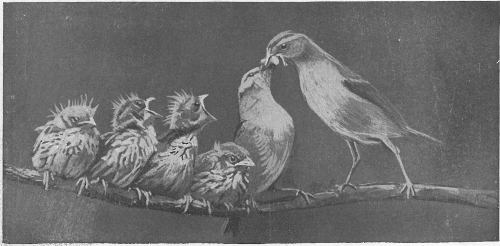E-text prepared by Stephen Hutcheson, Chris Curnow,
and the Online Distributed Proofreading Team
()


PREPARING BREAKFAST
(Two adult Chipping Sparrows breaking worm into pieces to feed young.)
BIRD GUIDE
LAND BIRDS EAST OF THE ROCKIES
FROM PARROTS TO BLUEBIRDS
BY
CHESTER A. REED
Author of
North American Birds’ Eggs, and, with Frank M. Chapman, of Color Key to North American Birds. Curator in Ornithology, Worcester Natural History Society.
GARDEN CITY NEW YORK
DOUBLEDAY, PAGE & COMPANY
1919
Copyrighted, 1906, 1909 by CHAS. K. REED.
[Preface] [Introduction] [BIRD LIST] [Color Key] [Classification] [Index]
PREFACE

The native birds are one of our nation’s most valuableassets. Destroy them, and in a comparatively few yearsthe insects will have multiplied to such an extent that treeswill be denuded of their foliage, plants will cease to thrive andcrops cannot be raised. This is not fancy but plain facts.Look at the little Chickadee on the side of this page. She wasphotographed while entering a bird box, with about twenty-fiveplant lice to feed her seven young; about two hundredtimes a day, either she or her mate, made trips with similarloads to feed the growing youngsters.
It has been found, by observation and dissection, that aCuckoo consumes daily from 50 to 400 caterpillars or theirequivalent, while a Chickadee will eat from 200 to 500 insectsor up to 4,000 insect or worm eggs. 100 insects a day is a conservativeestimate of the quantity consumed by each individualinsectivorous bird. By carefully estimating the birds in severalareas, I find that, in Massachusetts, there are not less thanfive insect-eating birds per acre. Thus this state with its 8,000square miles has a useful bird population of not less than 25,600,000, which, for each day’s fare, requiresthe enormous total of 2,560,000,000 insects. That such figures can be expressed in terms better[6]understood, it has been computed that about 120,000 average insects fill a bushel measure. Thismeans that the daily consumption, of chiefly obnoxious insects, in Massachusetts is 21,000 bushels.This estimate is good for about five months in the year, May to September, inclusive; during theremainder of the year, the insects, eggs and larvæ destroyed by our Winter, late Fall and earlySpring migrants will be equivalent to nearly half this quantity.
It is